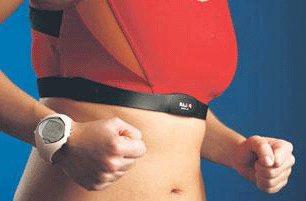 |
||
Using a Heart Rate MonitorA heart rate monitor works by detecting the tiny electrical pulses created by each heartbeat, which it picks up through ultra-sensitive electrodes which are strapped to your chest. The information is electronically transmitted to a watch-like receiver which you wear on your wrist, so that you can easily glance at the reading as you exercise. Strapless models use electrodes mounted on your wristband, but cannot give a continuous reading. The amount of information depends on how expensive a model you buy, but you can expect to be able to view your current heart rate, plus details of various zones of effort in which you can choose to work. The greater effort you put into your different types of aerobic exercise, the more oxygen your muscles need to work efficiently. The oxygen reaches your muscles in your bloodstream, so your heart has to pump more vigorously to get that oxygen to the muscles. That's why measuring the speed of your heartbeat is a good way of finding out just how hard your heart is working. It's a great way to kickstart your drive to tackle that menopausal weight gain. How to use a heart rate monitor By checking the reading, you can see instantly whether you need to work harder at your aerobic exercise program to achieve your goal, or whether you should slow down. Checking a monitor can be especially helpful if you're new to exercise and don't yet have a feel for how hard you need to work to give your heart a good workout, and is easier than stopping to take your own pulse. You can also use your heart rate monitor to track your improved fitness. As your body becomes stronger and fitter, it uses oxygen more efficiently, and so your muscles stop sending such strong signals for 'more oxygen' to your heart as you exercise. So, as your fitness improves, your heart has to work less hard for you to maintain the same level of exercise. What that means is that your heart rate reading will drop as you become fitter. You can see this improvement for yourself by wearing a monitor. When you first set up your heart rate monitor, you'll enter your Maximum Heart Rate (MHR) into it. The monitor will then show you when you are working at between 60-80% of your MHR (which is also your Target Heart Rate). It's important to stick within these zones when you're looking to lose weight during the menopause. This is the most effective rate of exercise for burning fat, and about 85% of the calories you burn at this level will come from fat. If you work harder, your body starts to draw on energy from your muscles, and the amount of fat you burn falls. Back to the top of Using a Heart Rate Monitor. |
OUR FREE REPORT!
Get the Healthy Eating Habit and Lose Weight For Ever 
We hate spam and will never give away or sell your email address |
|
|
|
||
FEEL GOOD IN YOUR BODY!Beat-menopause-weight-gain.com does not offer medical advice. Please consult your physician before making any changes to your usual lifestyle.View our Terms of Use and Privacy Policy |
||
|
Beat Menopause Weight Gain - Feel Good in Your Body! - All Rights Reserved - Copyright© 2008-2012
| ||


